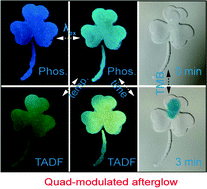Triple optically modulated and enzymatically responsive organic afterglow materials for dynamic anti-counterfeiting†
Abstract
Luminescent anti-counterfeiting is one of the extensively used strategies to combat the growing serious global forgery issue in modern society. Although many luminescent security labels have been developed, the majority of them are static and can be readily cloned due to their deterministic decoding mechanism. Therefore, an advanced dynamic anti-counterfeiting strategy is urgently needed. Herein, a multiple optical and biological response based label is developed for the first-time using o-phenylenediamine doped cyanuric acid as the information carrier that shows artificial enzyme activity and triple optical responses, i.e., fluorescence, thermally activated delayed fluorescence (TADF) and phosphorescence. The optical properties of the security label can be reversibly modulated with excitation-wavelength, temperature and time, respectively, and irreversibly modulated by enzymatic discoloration, making it difficult to duplicate. The fabricated organic information carrier shows multiple optical properties compared to the traditional TADF or phosphorescent materials with limited information encryption, making it more favorable for anti-counterfeiting. The visually verifiable afterglow label bearing multiple dynamic encrypted messages offers bright prospects for high-security-level anti-counterfeiting applications.

- This article is part of the themed collection: FOCUS: Macrocyclic and supramolecular chemistry


 Please wait while we load your content...
Please wait while we load your content...